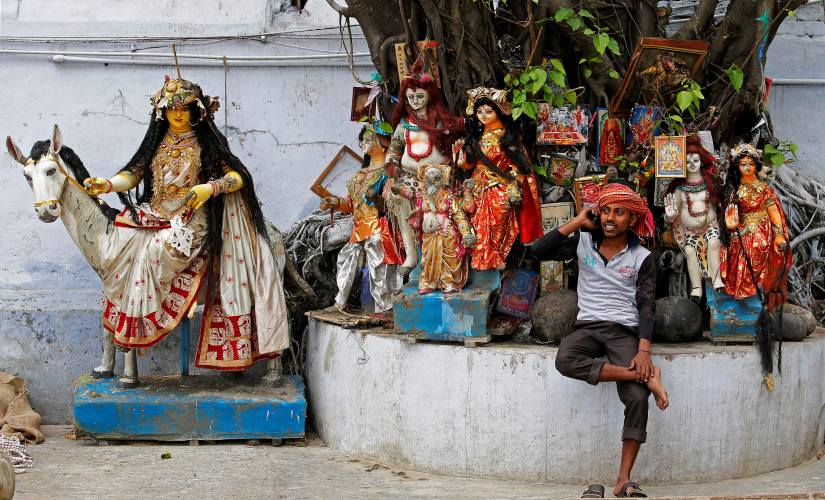Speaking of statues — and aren’t we all speaking of statues these days? — I got to thinking about good old-fashioned idol worshipping this week. Idol worship is also a great pun the Christian missionaries missed out on when they came to this country to try and spread the word of their own god versus the zillion others that already existed. Murtis, Indian statues, came about as a concept millennia ago, where anything physical could technically be a murti— a rock, a stream and so on — as opposed to the abstract. Some Vedic Hindus worshipped idols, others offered prayers to the ether, with nothing to physically bind them into place, so the word “murti” was debatable. However, the statues obviously won, because, by about 1 AD, murti was their word, as it were. Murtis back then could be of anything — dogs, trees, serpants, what have you, and bimba, which sounds like the masculine word for bimbo, began to mean “an image of god.” [caption id=“attachment_5546631” align=“alignnone” width=“825”]  Representational image. Reuters/Rupak De Chowdhuri[/caption] It only became a fully realised thing somewhere around the fifth or sixth century, when temples decided you couldn’t just bung in any old statue you felt like. It had to be made to measure, following a strict set of size and material guidelines, very up to the building code. They were your guests — whether in a temple or in a home — and while you didn’t exactly worship to them, you did make sure they were treated properly. Hey, remember back in the 1990s when everyone was convinced that a Ganesh statue was drinking milk? If you’re too young to remember this — basically a temple in Delhi announced that their particular murti drank an offering of milk. Hindus everywhere, across the world, rushed to feed their own statues milk, milk sales rose, that terribly balanced bunch, the VHP declared it a “miracle” and not one day later, scientists told everyone that it was some sort of capillary effect, and everyone was a victim of mass hysteria in this case, your statues were not drinking milk, etc etc. (Side note: I tested the milk thing a few days later, and since I didn’t have a statue of Ganesh handy, I used a Plaster of Paris image of a three-headed snake we had in the house. Lo and behold, my snake also drank the milk, and looked back at me smugly. A smaller “miracle” and one that went no further than my house, because no one was really that interested in a random milk drinking statue.) Here in Vietnam, where I’m writing this column from, there is a tradition of Hindu temples, brought in by the Cham dynasty. The Chams are mainly Islamic now, but there is a set called the Balamon Cham (“Balamon” derived from “Brahman”) who still practice Hinduism, and who are one of only two non-Indian Hindu followers in the world. The Chams were majorly into Shiva, and one of their surviving temples called Po Nagar, has several lingams (which still make me giggle) as well as Durga, and a mother goddess. The unusual thing about the main Po Nagar lingam (which was stolen according to records) was that it was a mukhalingam, or a phallus with a face. You could choose to convert your current lingam — your lingam statue, sorry — into a mukhalingam by adding a metal carved sheath with a face on it, which also sounds like a great accessory for your next big night out. But the lingam isn’t just a fancy you-know-what. The real meaning behind the phallus symbol and its often accompanying yoni is to represent the male and female powers of the universe. The idea of generation — yes, yes, it’s semen, but it’s not just semen, it’s how the world is made. It’s one of the few aniconic representations of faith in the world — the cross is another. Now, of course, you could pray to anything, if you liked. Your old Barbie dolls, that tree in the corner of your balcony, the birds in the sky. But people need places of worship, symbols of that worship too. Visiting a grave to “talk” to your family member, even though another part of you hopes they’re in heaven and not just hanging about waiting for you to call. Visiting an ancient temple while you travel so you can worship where so many other people have, and feeling their prayers against your skin. It must be nice to have somewhere comforting to go, a place where you can truly be selfish, and hope the universe is working out just for you. The world’s biggest statue, however, might just be about the statue maker and not the statue itself. Read more from the ‘Mythology for the Millennial’ series here . Meenakshi Reddy Madhavan is the author of several books, including The One Who Swam with the Fishes: Girls of the Mahabharata. She tweets @reddymadhavan
Murtis, Indian statues, came about as a concept millennia ago, where anything physical could technically be a murti— a rock, a stream and so on — as opposed to the abstract.
Advertisement
End of Article


)

)
)
)
)
)
)
)
)



